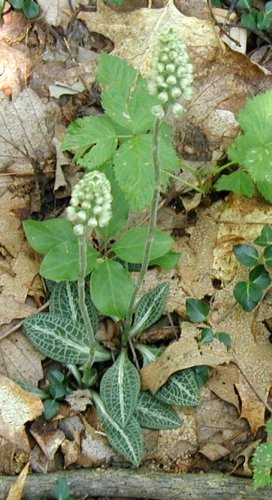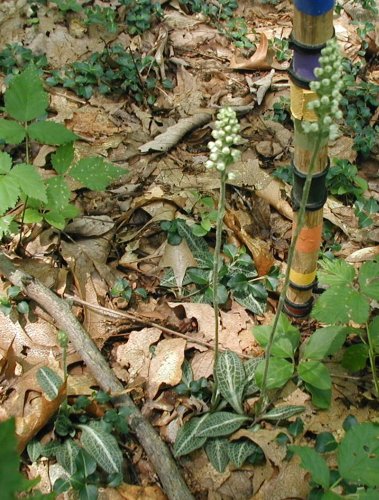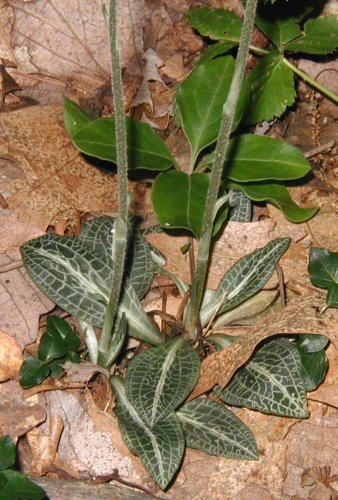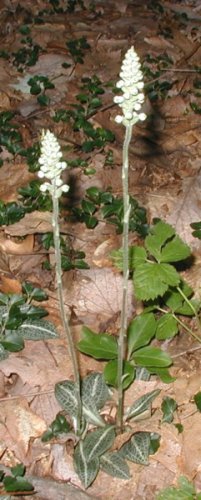Not too many flowers are found in Pennsylvania woods in the summer months of July and August. Most of the Spring flowers have now turned into berries and fruits. In a few days the elderberries should be near ready to harvest and the blackberries have been yummy this week!
One group that does flower in the heat of the summer is the Rattlesnake Plantains that flower in July and August. We are fortunate to have the most common species blooming in our woods called Downy Rattlesnake Plantain, Goodyera pubescens, a member of the Orchid family, Orchidaceae.
A single, fuzzy flower stalk tipped with a compact group of white flower buds rises up from a basal rosette of mottled leaves. The quarter-inch long flowers will open into the typical orchid-like irregular shape, having a large lower lip overshadowed by a group of fused petals.


Leaves in a basal rosette are oval in shape. The strong silver-white midrib contrasts with the dark green leaves. Veins that cross the leaf and run the length of it are all silver-white giving the leaf a unique, variegated look. The name “rattlesnake plantain” comes from the suggestion of rattlesnake skin by the pattern on the leaves.

Flower spike appears fuzzy or woolly, thus the “downy” part of its name. A few scale-like bracts are seen on the flower stalk.

Downy rattlesnake plantain leaves and roots were used by Native Americans for a number of ailments, but its collection and medicinal use are discouraged today due to its rarity.
I found rattlesnake plantain in the woodlands of the summer camp where I’ve served as the “storelady” for several years. I’ve always wanted to make a terrarium with rattlesnake plantain, removing 1 – 3 small plants. What is your opinion of this?
This year, on the annual search for the beloved plant, I was amazed and thrilled to find pipsissewa growing in the same area. I’ve seen the rattlesnake plantain for years; this is the first time I’ve spotted pipsissewa.
Thanks for your imput,
Sally Sainsbury
Hi Sally!
That sounds like a great summer gig, to be the storelady for a summer camp. I’ll bet you have lots of great stories!
In my area rattlesnake plantain is plentiful enough that removing a few plants wouldn’t be too detrimental. If you have twice as many plants as you want to remove, and it seems like you have since you’ve seen them in several years, I don’t think it would be a bad thing. Especially if the terrarium could be used to help educate other people about the fascinating wildlife that lives in our forests.
I can feel your excitement from finding a new plant – the spotted pipsissewa. Isn’t it fun? Next year, I wonder if you’ll be able to find more of it. Do let us know! BTW, what is your general location?
Good luck!
I was searching for this name of this plant when a friend provided this link. Just what I wanted to know (besides the name). I find it in New Hampshire, but only in 2 spots so far in the woods around our camp.
Hi Virginia,
Glad your friend shared the link! Keep looking for the rattlesnake plantain around your woods. They do tend to appear in clusters.
Have fun camping and thanks for stopping by!
I found this plant in the woods and as I was raised in the woods of eastern Pa, I was surprised to see a leaf unknown to me. I took a single leaf to id and after a good 45 minute search I have landed here. The site before yours said these plants were more of a New England thing. No state like New York or Pa was listed as states the plant grew. It is a neat plant and I am glad I got a chance to learn about it. Thanks!
Hi Sarah!
This little orchid is really eye catching, isn’t it? The design on the leaves is pretty unique with the silvery hatch-marks.
Did you get to see the flower or remnants of it? If not, go back and visit next year in high summer, July or August, to see the flower spike.
Not just anyone can say they’ve seen orchids blooming in the woods of Pennsylvania! Good luck.